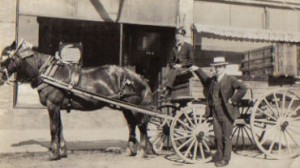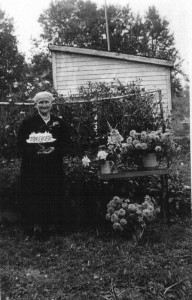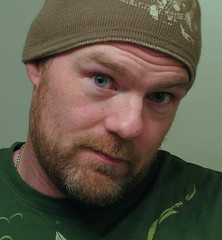Christian Cassidy is a rare find whose passion is rare finds.
I mean, how often do you meet a guy who’s not just willing, but eager to help you with family history research—for no greater reason than a passion for the hunt; someone who’s talented at what he does, and whose enthusiasm over his discoveries is palpable and contagious, and, best of all, who doesn’t express frustration even after receiving your, ahem, thirtieth email presenting him with yet another stray lead. In Christian Cassidy’s world of historical sleuthing, all leads are welcome, grist to his research mill.
Or, if not, he was diplomatic enough to make me feel this was so.
I was introduced to Christian, a Winnipeg-born history buff, photographer, and blogger, through one of my past students, Ruth Zaryski Jackson. Christian blogs at “West End Dumplings: Random Thoughts of a Winnipeg West-Ender” about urban politics and downtown living, and his primary historical focus is Winnipeg architecture and neighbourhoods—what he calls “built history.” But he had recently taken on the challenge of investigating the tragic story of Ruth’s great-aunt, Lena Huckan, who immigrated to Winnipeg in 1910 from Repuzhintsy (in what is now Ukraine). Lena died in 1918, at the age of 24, in a Winnipeg hotel fire. The result of Christian’s exploration is a compelling series of blog posts on West End Dumplings, accompanied by photographs, on the ill-fated Riverview Hotel in Elmwood and Lena Huckan’s life and death.
Through my own genealogy research I had discovered that my great-uncle Blake Arthur Latta too lived for a time in Winnipeg. From my great-grandmother Anna (“Annie”) Maria Latta’s death certificate I learned that she died in 1942 while visiting her son Blake in Winnipeg. The certificate gave the street address of the Latta home there, and a friend of mine who lived in that city went strolling one day, noticed that the house is still standing, and photographed it for me. Blake’s family—his parents and brother (my grandfather)—had settled in Edson and later Edmonton, Alberta (192 kms east of Edson). Edson was Annie’s permanent home right up until her death. So I couldn’t help but be curious about the life route Blake, and his wife and two daughters, had taken to reach Winnipeg.
I wish he’d written and left behind a memoir, but since he didn’t, the next best thing is Christian Cassidy.
Recapturing and sharing the long-lost stories of Winnipeg neighbourhoods is one of Christian’s raisons d’être; if he can put a human face to the tale, all the better. He agreed to poke around in historical directories and archives and see what he could come up with on Blake, and over the next few weeks, as a result of a series of finds, deductions and further finds, he unearthed a great deal about my great-uncle’s life and his work for CN Express. Much of it no one in my family now living had known, including Blake’s daughters, Wilma and Nan.
Christian’s multipronged strategy includes everything from whipping around the Internet, to riffling through dusty archival files, to leaping tall snowbanks (well, in winter anyway) in a single bound in pursuit of up-to-date photographs of some of the structures he describes. From various sources he ferreted out older images that create a rich landscape for Blake’s story that words alone could not, recapturing Winnipeg of the 1940s.
I can’t tell you how excited I was when the first essay of the series, titled “Blake Latta and CN Express (Part I),” was posted and I saw how Christian had woven the information and photos into what he calls a “montage.” It’s more than that by my definition. But read it and see for yourself. The series will continue over the next couple of weeks.
It’s the nature of family history research that one path of inquiry inevitably branches off into several, and each of these, exponentially, into many more. I found out through Christian that Edson, Alberta, one-time home of the rest of Blake’s family, is celebrating its centennial this year. The Lattas had moved there from Ontario in 1910, the year before the town was incorporated. Browsing the online photo archives, I came across grainy but precious images of my great-grandfather and great-grandmother, Anson and Annie Latta, and my grandfather, Elgie Ward Latta. Another page added to the family story . . . also thanks to Christian.
As an amateur genealogist I’m fascinated not just in the how of others’ research, but also the why. I asked Christian what fuels his passion for his subjects.
“I’ve always had an interest in local history and been very aware that most people don’t know the most basic things about the city of Winnipeg’s past, or the history of some of the phenomenal buildings we have in town. Local papers, a TV morning show and one of the forums I was a member of all had a ‘This Day in History’ section that, I assume, was taken from some U.S. wire service as most of the events had to do with the U.S. civil war or what some U.S. president did.
I challenged people in the forum that, really, Manitoba had just as interesting a history as anyplace in the U.S. and I started contributing pieces of my own dug out from newspaper stories or building histories. People enjoyed it and I carried it on until it became a regular feature. After enough content was pieced together I put it into blog form and whenever possible included a link and photo relating to the event. The digging I had to do to find items for the blog gave me a pretty good sense of what was available online.
Now, five or so years later, I am still at it and the resources available online have grown exponentially so I can dig even deeper into the topics.”
How does he generally begin his search?
“My research on a person usually starts with Henderson Directories. [For Winnipeg, these annuals go back to 1880.] Once I get a snip of where my subject lived or worked, or their profession I can extrapolate from that. I will try searching the newspaper archives online, or go to fiche if there is a specific date to search. For most of the people I research they rarely, if ever, make the papers (e.g., Huckan or Harvey). I will then search the company name or their profession and can usually find material that I can make ‘best guesses’ on. (For instance I don’t KNOW that Blake Latta worked in a third-floor office at that building on Portage and Main but from newspaper clips about the company and checking street directories of the day for alternative locations I’m very confident that there is nowhere else in the city that he could have worked for those years.) From there, for a time, that building’s history/surroundings and those of the subject merge.
That merging is the part I enjoy the most. I’m not necessarily a ‘people history’ person, but love built history. For Blake’s post, learning about the CN Express site and being able to compile what is probably the only history on a long-forgotten structure is rather exciting. I can also tie in information on the Forks Market and an apparently famous café of the day in the building next door that Blake would certainly have eaten at. The Lena Huckan and William Harvey essays too were really more a montage of building and neighbourhood histories than they were personal histories, but to a large extent, these are one and the same.
I have to admit that the Lattas were in a ‘sweet spot’ timing-wise. There are a number of history sites in Manitoba that pay special attention to the WWII era. Though Blake wasn’t involved directly in the war, I was able to benefit from the additional photos, essays and newspaper scans from the time that could be searched via Internet.
I’ve never been one for ‘sexy’ buildings or people (historically speaking!). In all of my blog work there isn’t one Premier or Lieutenant Governor profiled and I barely mention the Manitoba Legislature or even Eaton’s. I really enjoy researching ‘common’ people and the neglected buildings that people pass by a thousand times and never give them a second thought. That, to me, is history. It does make my job tricky because there usually isn’t a starting point—I have to start from scratch, wherever I can, and work backwards and forwards from there. I guess that has heightened my sleuthing abilities by, say, forcing me to research a couple of other buildings in the area to see what I can deduce about the one that I am actually interested in.
As for me? I have a BA in Canadian Studies and Political Science but I have always been an office administrator type. Right now I do payroll for an infectious diseases non-profit (and I do their weekly media scans, which I guess somewhat calls upon my Internet sleuthing abilities).
It is the research that I love and less so the writing. I put that off until the end—which is why I am up a lot at 2 a.m. pounding out posts!”
CHRISTIAN CASSIDY blogs at West End Dumplings and This Was Manitoba.



Allyson,
I love this probing interview with Christian Cassidy about his stories of Winnipeg people, buildings and neighbourhoods. He is indeed a rare find!